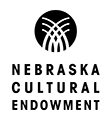The Project
The Gift | Fort Omaha History | The Art ProjectOther Contributors | Fringe Benefits | The Native Tradition
The Gift
To often we fail to understand the importance of a simple gesture. While a gift is significant in any culture, the value of the gift may vary depending on who's gifting and who's receiving. The story of the Buffalo Robe Project begins with the gesture of a gift of a blanket, and the desire to share that significance with our community.
In 2011 at the 20th annual Fort Omaha Campus Intertribal Powwow, Lakota artist Steve Tamayo, from the Rosebud Reservation in South Dakota expressed his gratitude for the two decades of outreach to the Native community that Metropolitan Community College has extended with the powwow. The hide was traditionally brain-tanned by the artist on the reservation. At the powwow, he wrapped it around the shoulders of our college president in a special presentation.
The gift of a blanket to the Native people of America is an intimate gesture that offers warmth and protection. It is a symbol of friendship and peace. As a community college, we felt that it was necessary to acknowledge this gift, not as an act of self-interest, but rather, as a symbol of our gratitude to the Native American community in Omaha for their work and dedication to the powwow.
Fort Omaha History
The following year, MCC consulted Steve Tamayo after it was decided that the hide should be a work of art on public display. Tamayo suggested that a winter count, a traditional Lakota means of recording history, could be painted, documenting the history of our Fort Campus; this land that was once Native land, then became occupied by the US Army. In 1975, after becoming MCC, it was public. Since 1991, Native peoples have been invited to dance on the site that once held Chief Standing Bear as prisoner here during the landmark trial that ended in the judgment that Native peoples are, in fact, people.
It is this history and this hide that would be the foundation for the project and a special course, Art of the Americas. After submitting several grant applications, MCC was awarded nearly $12,000 from the college foundation and the Nebraska state arts and humanities councils. This afforded the college to be able to secure Mr. Tamayo as a visiting artist for the summer and instruct students in the traditional arts of the Plains Indians.
The Art Project
During the summer quarter, the instructor, Susan Trinkle Healy and seven students in the Art History class collaborated with Tamayo, local artist Therman Statom, The Kaneko Foundation, Douglas County Historical Society and the broader community to research the rich, but often troubled, history of Fort Omaha.
Not only did Art History students have the opportunity to work on the project, but involvement with research and writing extended to students in courses across the disciplines. Topical essays on the subjects represented on the winter count were contributed by students in Comparative Religion classes. Presentations and workshops were held for education students in history classes at a neighboring institution. Video/Audio Communications students attended class sessions and field trips to document the project that they will in turn use for their own course assignments.
Other Departments Getting Invovled
In following quarters, faculty from departments in the arts, humanities, social sciences, and information technology are incorporating the hide, now on view in our gallery, into their curricula.
Another exciting aspect of the project in addition to community collaboration was the merging of tradition and innovation. The class was taught using the very old and traditional medium of hide painting. Students hiked through the forest to identify centuries-old earth lodge sites where Nebraska Indians once lived, long before they recorded history.
They also visited the site of a turn-of-the-century boarding school, where assimilation efforts were carried out. One student collected natural pigment from the Loess Hills in neighboring Council Bluffs, Iowa. All the while, the project was recorded and documented on iPads that each student kept during the quarter.
While wi-fi didn't always extend deep into the forest, students were able to record narratives from our guide and upload to a blog later. They compiled and scanned documents from the historical society, and in an instant, transferred them to students who were in the studio painting images on the hide.
Fringe Benefits
Perhaps the most exciting aspect of this class was not the technology or the tradition, but rather, being able to see a class work together as a team, each one exhibiting and contributing their individual gifts to the common goal of creating the work of art and telling the story of a shared land.
While some students mastered researching skills, others demonstrated their artistic talents by drawing out the icons. Others maintained the blog and some wrote catalog entries to explain the images. Allowing each student to demonstrate learning through the medium and means of which she or he best communicates allowed for even deeper learning. Each contribution was important and each student relied upon the others. Attendance and completion of the class was successful, due to the shared responsibility of each student. Not only was it content that these students took away, but also understanding and compassion for a cultural history that has been voiced, but not often heard.
The Native Tradition
The Native culture holds a very different world view, and an equally different educational methodology. Traditionally, native peoples have learned in collaboration with elders and the community at large. In mainstream American culture, where traditional education is institutional and academic, our students learned the value of oral and pictorial history. They also understood the value of experiential learning and how it applies to their lives, work, and education today.
This example of creative education is not site-specific. Each college and community has its own history, and likely, each city has its own Native American history. Possibly, it has been overlooked. Each college has an opportunity to connect with the Native community, respect their elders as the keepers of history, and collaborate to create a narrative of that history.
More Information About Winter Counts
This project began with a trip to the Smithsonian. To learn more about Winter Counts you can visit their website






